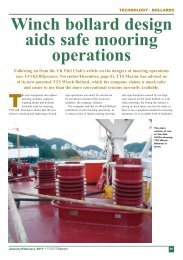Cassettesystems for ContainerTerminals.pdf - TTS Group ASA
Cassettesystems for ContainerTerminals.pdf - TTS Group ASA
Cassettesystems for ContainerTerminals.pdf - TTS Group ASA
You also want an ePaper? Increase the reach of your titles
YUMPU automatically turns print PDFs into web optimized ePapers that Google loves.
POWER TO MOVE<br />
www.ttsgroup.com<br />
Cassette systems <strong>for</strong><br />
container terminals<br />
<strong>TTS</strong> cassette systems are designed both <strong>for</strong> safety and with a committed<br />
responsibility to the environment in and around container terminals. These two<br />
considerations combine to govern the improvement of capacity and system<br />
reliability, generally improving the cost-efficiency of container port logistics.<br />
PORT AND LOGISTICS
CASSET TE SYSTEMS FOR CONTAINER TERMINALS<br />
The <strong>TTS</strong> cassette system<br />
provides an efficient means<br />
of transporting containers<br />
in order to simplify every<br />
operational process in a<br />
container terminal. The<br />
system fulfils many important<br />
prerequisites among which<br />
are safety, flexibility and<br />
confidence in the equipment.<br />
A cassette is a steel plat<strong>for</strong>m<br />
that safely supports cargo,<br />
such as containers, while<br />
being quickly trans ported.<br />
Containers can be stacked<br />
and transported on a single<br />
cassette in a variety of<br />
Transportation options<br />
Since a cassette is not<br />
self-propelled it needs to be<br />
connected to a vehicle, either<br />
manned or unmanned, in<br />
order to be transported. The<br />
integration of cassettes into<br />
the terminal system increases<br />
the productivity of transport<br />
vehicles since they can pickup,<br />
transport and drop-off<br />
the cassette without waiting<br />
<strong>for</strong> a container to be loaded<br />
or unloaded. When the vehicle<br />
drops off a cassette, it can<br />
immediately move to the next<br />
one <strong>for</strong> a pick-up.<br />
The same is true <strong>for</strong> quay<br />
cranes – their productivity is<br />
configurations, <strong>for</strong> instance<br />
2 x 40’; 1 x 40’; 1 x 45’; or<br />
even 2 x 20’. In the case of<br />
double-stacking the upper tier<br />
is secured by cell-guides which<br />
are built as part of the cassette<br />
structure.<br />
increased because the transfer<br />
of container between vessel<br />
and quay uses the cassette as<br />
a ‘buffer’, which minimises the<br />
waiting time <strong>for</strong> vehicles such<br />
as translifters and C-AGVs to<br />
become available.<br />
<strong>TTS</strong> offers several vehicle<br />
options <strong>for</strong> transporting<br />
cassettes, which are all fully<br />
adapted to the cassette system.<br />
Translifter<br />
The <strong>TTS</strong> LT translifter is<br />
designed to be coupled to<br />
any universal towing tractor.<br />
These manually operated<br />
vehicles lift and transport<br />
cassettes, together with which<br />
Terminal cassette loaded with 2x40’ containers<br />
they create a flexible, reliable<br />
system <strong>for</strong> container terminals.<br />
The deployment of <strong>TTS</strong><br />
translifters is able to reduce<br />
the total number of required<br />
vehicles by approximately 50%<br />
compared to conventional<br />
tractor/trailer solutions.<br />
The translifters are of robust<br />
construction, designed <strong>for</strong> long<br />
service in container operations.<br />
Construction is the result of<br />
computer aided design and<br />
rigorous strength calculation.<br />
The translifter’s driver-friendly<br />
manoeuvrability in confined<br />
spaces increases overall<br />
container loading efficiency.
CASSET TE SYSTEMS FOR CONTAINER TERMINALS<br />
C-AGV<br />
<strong>TTS</strong> has also developed a<br />
range of automated cassettecarrying<br />
vehicles <strong>for</strong> container<br />
terminals, including the<br />
groundbreaking C-AGV.<br />
The C-AGV has been<br />
designed not only to improve<br />
container handling safety<br />
by virtue of its advanced<br />
automation features but also<br />
to improve environmental<br />
impact by reducing the<br />
number of vehicles required<br />
to transport a given number<br />
of containers. Also, the new<br />
‘tribrid’ engine technology<br />
allows diesel consumption to<br />
Twin-loaded cassette in transport<br />
be reduced by up to 40%.<br />
With a load capacity of 61<br />
tonnes, the C-AGV is able to<br />
carry cassettes with either<br />
double-stacked 40’ containers<br />
or two 20’ containers in a<br />
single tier.<br />
Major innovations in<br />
manoeuvrability have been<br />
made by incorporating<br />
individual, electrically-driven<br />
and steered bogie axles which<br />
enable the C-AGV to be<br />
moved in any direction and<br />
to turn through 360 degrees.<br />
This increases versatility and<br />
flexibility while minimising<br />
congestion at the quayside.
CASSET TE SYSTEMS FOR CONTAINER TERMINALS<br />
The C-AGV can be steered<br />
conventionally or ‘crab’<br />
diagonally, or it can move<br />
completely transversally. New<br />
cassette designs enable the<br />
C-AGV to enter and exit both<br />
transversally and longitudinally,<br />
enhancing the system’s<br />
cargo handling efficiency.<br />
With their unique sideways<br />
manoeuvrability, the latest <strong>TTS</strong><br />
AGVs are designed to enter<br />
the cassette from either end<br />
or side. As such, the distance<br />
between the stacking cranes<br />
and the quay wall can be<br />
<strong>TTS</strong> Port Equipment AB<br />
Kämpegatan 3<br />
SE-411 04 Göteborg<br />
Sweden<br />
Tel: +46 31 725 79 00<br />
Fax: +46 31 725 78 04<br />
info@tts-port.se<br />
www.ttsgroup.com<br />
reduced dramatically – by<br />
approximately 40m compared<br />
to traditional LoLo AGV<br />
requirements. This gives the<br />
terminal operator a significant<br />
increase in valuable space <strong>for</strong><br />
stacking containers.<br />
The excellent manoeuvrability<br />
of the AGVs also allows the<br />
possibility to increase the<br />
number of transfer points*<br />
under the stacking cranes and<br />
STS cranes (even if the STS<br />
cranes are placed shoulder to<br />
shoulder). This means that both<br />
crane- and traffic-management<br />
<strong>TTS</strong> Handling Systems AS<br />
Holterkollvn 6,<br />
NO-1441 Drøbak<br />
Norway<br />
Tel: +47 64 90 79 10<br />
Fax: +47 64 93 16 63<br />
info@tts-hs.no<br />
<strong>TTS</strong> Liftec Oy<br />
Sorkkalantie 394<br />
33980 Pirkkala<br />
Finland<br />
Tel: +358 3 3140 1400<br />
Fax: +358 3 3140 1444<br />
sales@tts-liftec.fi<br />
systems are given a buffer of<br />
cassettes to work with, offering<br />
greater flexibility in planning<br />
and there<strong>for</strong>e productivity.<br />
Also it has been proven that,<br />
by handling 50% of all 40´<br />
containers in double stacked<br />
arrangement, the number of<br />
AGVs could be reduced by<br />
approximately 30%.<br />
* Transfer points are positions<br />
where cassettes are placed<br />
under the cranes to load or<br />
unload containers<br />
PORT AND LOGISTICS




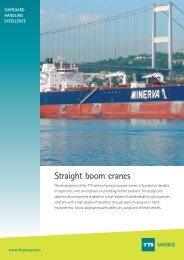

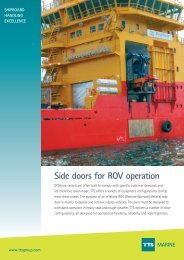
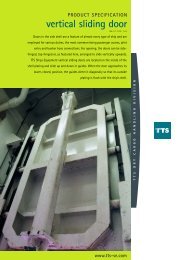
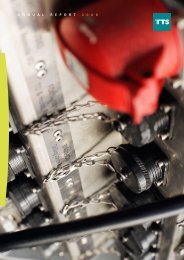


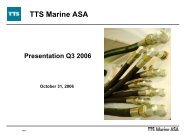
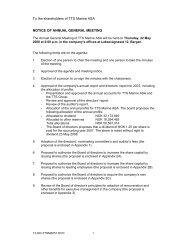
![2012.MasterPresentation_final [Compatibility Mode] - TTS Group ASA](https://img.yumpu.com/4612021/1/190x146/2012masterpresentation-final-compatibility-mode-tts-group-asa.jpg?quality=85)


